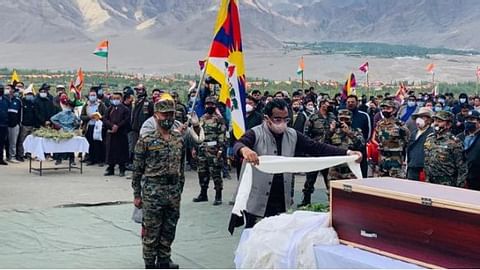Martyred Tenzin Nyima Had Told His Family : Tibetan Sff Is Finally Fighting The Chinese Occupation Force

When Tenzin Nyima was growing up in India’s western Himalayan region of Ladakh, his parents, worried about his strongheaded ways, sought out a local oracle for guidance. The sage told the family, who had fled to India from Tibet in 1966 several years after a failed uprising against Beijing, to stop fretting.
Nyima was destined to be a “brave soul”, he said. Indeed, in 1987, Nyima, just 18, went to an army base in Leh, the capital of Ladakh, asking to be recruited into a secretive Indian paramilitary unit with Tibetan soldiers, known as the Special Frontier Forces.
On August 30 this year, Nyima’s mother Dawa Palzom, 76, was reminded of the oracle’s words when she got off the phone with Nyima.
The 51-year-old, a company leader in the SFF, had made a surprise call to her at her home in Choglamsar, a town in Leh, from a forward position along the Line of Actual Control (LAC) – the loosely defined line separating Indian territory from Chinese Occupied Ladakh.
Nyima’s older brother, 54-year-old Tenzin Nyawo, said Nyima sounded “tense”. This was not surprising given Nyima and his company were stationed in mountain passes 200km away, where Indian troops were locked in a bitter and tense stand-off with Chinese troops at various points along their 3,488km undemarcated LAC, bringing political ties between the nuclear-armed neighbours to their lowest point in decades.
A deadly clash in June, in which soldiers engaged in hand-to-hand combat that left at least 20 Indian men and over 40 of Chinese soldiers dead, had led to both sides ramping up troop, vehicle and armament reinforcements despite numerous rounds of military and diplomatic talks to ease tensions.
Nyawo recalls his brother telling their mother that “the situation at the LAC was tricky”.
“He said anything could happen,” he said in a video call on Tuesday.
Nyima wanted to talk to his three children, the youngest only 5, and his wife, but he could not reach them. “He ended the call by saying, ‘Please pray for us’,” Nyawo recalled.
Palzom and Nyawo did so, but the prayers were not answered. Nyima was killed a few hours later when a landmine exploded while he was patrolling in Chushul, on the southern bank of the Pangong Tso glacial lake, where India and China have accused each other of changing the “status quo” over the LAC. Another soldier from the SFF, Tenzin Loden, was injured.
It later emerged that the night before Nyima’s call, Chinese soldiers had clashed with Indian soldiers in Chushul, as the Chinese attempted to re capture a string of strategic high-altitude areas.
“We later learnt that the SFF had played a crucial role in capturing these heights. Shortly after he called us, Nyima went patrolling to ensure that the heights were impenetrable when the mine exploded,” said Nyawo.
While tensions at the LAC remained high – even resulting in warning shots being fired for the first time in four decades earlier this month – both sides have taken steps to stabilise the situation. On Tuesday, military commanders agreed to stop sending troops to the front lines.
The SFF was formed midway through the 1962 war between India and China, with the initial aim of carrying out guerrila operations against the Chinese Occupation Forces.
Its formation prompted a roaring response from Tibetan refugees in India. John Jones, the campaigns and advocacy manager at Free Tibet, a London-based not-for-profit group that campaigns on issues of Tibetan freedom, said that such enthusiasm was common among the Tibetan community in India.
“Tibetans who serve in the unit can see it as a chance to get their country back or show gratitude towards India by defending the country that took them in,” he said.
New Delhi has always remained tight-lipped about its existence, employing it in various operations such as the 1971 and 1999 wars with Pakistan, but never officially commenting on it.
Hence, Nyima’s death was not officially announced – the Indian defence ministry’s statement on the clash, which said the Indian troops had “pre-empted” Chinese troops who “carried out provocative military movements,” did not mention it. But one of Prime Minister Narendra Modi’s top aides, the national general secretary of the ruling Bharatiya Janata Party, Ram Madhav, paid respects at Nyima’s funeral, laying a wreath on his coffin at a ceremony that awarded him full military honours.
Analysts said this was a clear sign to Beijing that India was not ruling out playing the “Tibet card”, by using the Tibetan diaspora in India as a diplomatic foil against rising Chinese assertiveness.
This would be a red line for Beijing, which has made clear it will go to great lengths to quell separatism, anywhere from Xinjiang to Hong Kong to Taiwan.
As photos of Nyima’s coffin, wrapped in the Indian tricolour flag and the snow lion flag adopted by the Tibetan refugee diaspora, began circulating online, India’s Tibetan community, thought to number about 85,000 as of 2018 and spread in settlements across the country, hit the streets, holding rallies to support the SFF and Indian military personnel.
Cars and motorcycles flooded Leh’s streets, all of them headed to Nyima’s funeral. The Lieutenant Governor of Ladakh RK Mathur has vowed to donate 500,000 rupees (US$6,800) to Nyima’s family.
For Nyima’s family, including his three children and wife, the crowds, the adulation and the attention was unimaginable. Nyima’s parents left Tibet in 1966, among the thousands who followed in the footsteps of the community’s spiritual leader the Dalai Lama who had sought refuge in India seven years earlier.
Nyawo said his parents recounted the “oppression” and “propaganda” by Chinese authorities. Like others who crossed dangerous, hostile terrain to be in India, Nyima’s parents walked across high, rocky mountainous ranges and passes for two nights, before they reached Changthang, in Ladakh.
Having traditionally lived a nomadic existence, Nyima’s parents made Changthang, a pasture in southeast Ladakh, their home and lived there for more than two decades before they came to Choglamsar, one of more than 45 “settlements” – special colonies for Tibetan refugees – constructed by the Central Tibetan Authority (CTA), the Tibetan government-in-exile and Indian authorities.
Through it all, their existence, like thousands of other Tibetan refugees, was firmly in the shadows.
As refugees, Tibetans are not entitled to government jobs, neither are they allowed to own land or property in India, unless they opt for Indian citizenship. Without Indian citizenship, even private sector jobs can be hard to come by and travelling across borders on “identity certificates”, issued by the Indian government, rather than passports, can be tedious. These could have contributed to the community’s dwindling existence, with the 2018 government estimate showing the population of ethnic Tibetans had almost halved from 150,000 in 2011.
Nyima’s family said he wanted to break out of the cycle of impoverishment that had marked the lives of others in the community and so at the age of 18, he asked to sign up with the SFF.
His family had no clue. Looking back, Nyawo said, “He knew that the family could not afford his studies for much longer. He had hoped that a job with the SFF would help him to make a decent living.”
Nyima went on to spend more than 30 years in the SFF and was even part of the Indian effort against Pakistan in 1999, when the two countries fought in a two-month war in Kashmir’s Kargil district. But for nearly all of that time what he sought most eluded him.
In July, during Nyima’s last home visit, that position finally changed. He was being sent to the forward areas along the border and was barely able to conceal his excitement.
“He told me, Nyawo, this is not the same as it was. This is not Kargil or Bangladesh, we are finally fighting our enemy,” Nyawo recalled, referring to the two India-Pakistan wars the SFF fought, in 1999 and 1971.
Nwayo said the excitement was natural. “Every Tibetan wants to fight China, because that fight is not just for India, it is also for our own land. It is also for our identities, that were snatched away from us.”
Nyima understood that the fight, this time, would be unlike any other, said Nwayo. “At 51, he was not as fit but he was raring to go. He said this fight was very important and that he might not return home alive.”
For Nwayo, the loss of his brother has been hard, more so because Nyima was to retire next March. “He was so excited about finally getting time to spend with his family, after 33 years of staying away.”
But like thousands of those who mourned Nyima’s death, Nwayo knows the family’s loss has brought a larger gain for the community. For years, the SFF and the Tibetan community’s contribution was unknown to the world, he said.
“In his death, he changed all that.”



